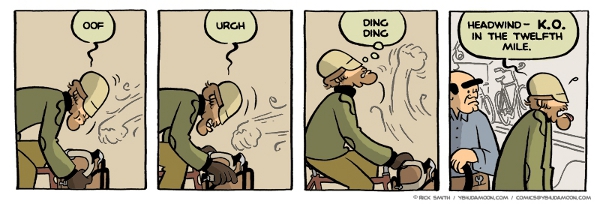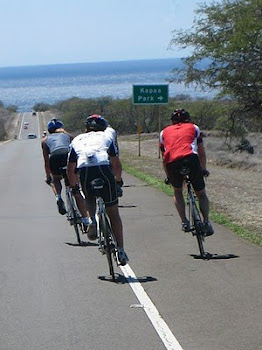While it’s nice that Christchurch doesn’t have much in the way of hills to deal with, it makes up for that by having fairly persistent winds. One day it’s a strong nor’wester, then it’s a beast’ly easterly, then a bitter cold southerly. And knowing my luck, it’s usually in my face both going to work and home again…
More worrying is when the wind gets particularly strong and gusty; I can deal with a bit of cold or rain when I’m riding (heck, even cycling in the snow is quite fun…), but a gale-force wind is the one where I do sometimes fear for my safety with the chance of being blown over or knocked into the path of another vehicle.

So what are some handy tips for dealing with strong winds?
- Timing can be key, so it’s important to understand how winds change over the day. For example, typically an easterly sea breeze doesn’t get up until the afternoon around Christchurch. Likewise, strong north-westerlies often die down around sunset. Weather forecasts can also give you useful information about likely changes to the strength and direction of winds. So if you have some flexibility in when you need to be riding, try to take these things into consideration.
- It’s hard to beat basic physics – wind resistance is all about aerodynamic drag. If you have a head wind you want to make yourself as small as possible, so hunch right over your bike. If you are riding with company, take turns in the lead shielding the follower from the brunt of the wind (that’s why cycling peletons ride in closely spaced formation).
- Likewise, you may want to rethink any clothing that is going to flap about or create a drag-parachute behind you. Choose form-fitting clothing, e.g. zipped up tops, leggings/trousers.
- Use those gears – just like riding up a hill, a lower gear than usual can make the pedalling easier (conversely, take advantage of a strong tailwind by using a higher gear than normal).
- If you can, pick a route that has buildings, trees, walls – anything to shelter you from the wind. Be careful when you reach gaps in the shelter however, that a sudden cross-wind blast doesn’t knock you.
- Lighten the load – why carry extra weight you don’t need when fighting a headwind? If you have a choice of bikes, pick your lightest, most aerodynamic one. If you don’t need your bike rack, panniers, basket, or whatever, remove them.
-

Leaning into a strong cross-wind If need be, slow down. This is particularly important if you’re encountering strong cross-winds or variable gusts that want to try to knock you over (be especially careful when zooming downhill). Give the wind less to fight against. If it really gets bad, hop off and walk for a while.
- If you’re worried about being suddenly pushed over towards traffic, try to give yourself a bit more room than normal from passing vehicles. If there isn’t a nice shoulder you can hide in, one option is to actually ride a bit further out as you hear/see an approaching vehicle (so that they shift over) and then move back to the left before they get to you. Also be careful that, while leaning into a cross-wind, you don’t inadvertently veer towards traffic (especially if they temporarily block the wind from you).
- There is a technological way to deal with those winds – an electric bike. With an e-bike you will reduce the effort needed when pedalling into a strong headwind – Wellington Mayor Celia Wade-Brown swears by one.
- If you are not seeking a particular destination but just going for a recreational ride, I strongly suggest heading into the wind to start with and then letting it blow you home later (this does of course assume that the wind doesn’t change direction or die down later…). It means that, after you have done the hard yards first up (while you still have energy), you’ll be able to coast home later when you’re starting to get a bit weary.
- Alternatively you could consider trying a “tacking” route, where you alternate between having the wind in your front and behind by regularly making a right-angle turn on your route. That way you get a regular breather from pushing into the wind all the time. Christchurch’s grid networks of streets lend themselves nicely to this approach (e.g. my ride home in a south-eastern direction is often greeted by a strong north-easterly that I can zig-zag through).
- Those winds really getting too much for comfort? Don’t be a martyr if you have a car or bus option – save your ride for another day. Remember if you already have your bike with you somewhere, you can always pop it on a bus to get home.

Ultimately it’s hard to completely fight nature when the wind picks up; sometimes you can avoid it and sometimes you just have to grit your teeth and press on. Here’s hoping you encounter as many tailwinds as headwinds…
How do you deal with riding in strong winds?

That was awfully good timing – you post this on a day where there’s a 35 km/h norwester in Christchurch!
I may have looked at the forecast… Been meaning to write this one for a while.
I LOVE my electric bike – particularly for commuting. I was noticing yesterday in the wind that beacuse it is heavier, I am much more stable in a strong side wind than when on a normal bike – not to mention that I still go forwards at a reasonable pace when biking into the wind (or up a hill). I still like the “biofuels” bike for recreational rides, but it is nice to arrive on time and not too sweaty and disheveled to meetings and work and yet have all the advantages of a bike – cheap, fun, don’t get stuck in traffic and easy to park.
head wind ? , or urbanised resistance training !
Headwinds, they just make you more fit. 🙂
Or you can put your bike on the front of the bus.
as you already state above.